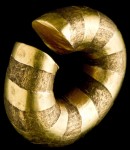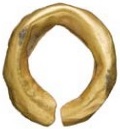 Four Bronze Age artifacts discovered in Wales by a metal detectorist were declared treasure trove at a coroner’s inquest on Wednesday. A gold and silver ring and three fragments of copper ingots were found on farmland in Cwm Cadnant, on the North Wales island of Anglesey, by Philip Cooper in May and June of 2013. Although archaeologists believe the artifacts were buried together as a single hoard, over the centuries they’d been scattered by movements of the earth and farming activities so Cooper found them several meters apart.
Four Bronze Age artifacts discovered in Wales by a metal detectorist were declared treasure trove at a coroner’s inquest on Wednesday. A gold and silver ring and three fragments of copper ingots were found on farmland in Cwm Cadnant, on the North Wales island of Anglesey, by Philip Cooper in May and June of 2013. Although archaeologists believe the artifacts were buried together as a single hoard, over the centuries they’d been scattered by movements of the earth and farming activities so Cooper found them several meters apart.
The find was reported to Ian Jones, curatorial officer at the Oriel Ynys Môn, an art and history museum in Anglesey, and Roland Flook, curatorial archaeologist at the Gwynedd Archaeological Trust. The artifacts were then examined by archaeologists at the National Museum of Wales who determined that the ring is a piece of Bronze Age jewelry known as a hair ring and that the ingots were a shape know as cake form used as raw material in the making of tools and weapons, typically found buried in Late Bronze Age hoards. That puts the date of the hoard at 1000-800 B.C.
 The hair ring is made of a bar of gold that was curved and then had silver strip wrapped around the surface horizontally to give it a handsome two-tone striped look. It’s a pennanular design — an incomplete ring — and the terminals are flat. One side of it is heavily worn from repeated use before it was buried. They are commonly found in England, Ireland and Wales, including Anglesey.
The hair ring is made of a bar of gold that was curved and then had silver strip wrapped around the surface horizontally to give it a handsome two-tone striped look. It’s a pennanular design — an incomplete ring — and the terminals are flat. One side of it is heavily worn from repeated use before it was buried. They are commonly found in England, Ireland and Wales, including Anglesey.
A more simple piece made of sheet gold rather than bar and without the silver stripes was discovered at Trearddur during an excavation in advance of construction conducted by the Gwynedd Archaeological Trust in October of 2007. Although these adornments are thought to have been worn in the hair, they could also have been worn as earrings with the  curved gold bar being inserted into a pierced lobe. The image to the right is the Trearddur hair ring at twice life size, so you can see how it could fit in an ear although it would certainly require a largish hole.
curved gold bar being inserted into a pierced lobe. The image to the right is the Trearddur hair ring at twice life size, so you can see how it could fit in an ear although it would certainly require a largish hole.
Adam Gwilt, principal curator for prehistory at National Museum Wales, said: “This gold hair-ring is finely made and was once worn by a man or woman of some standing within their community.
“It could have been made of gold from Wales or Ireland. The copper ingot fragments are an important association with the ring.
“It would be interesting to know whether they were transported and exchanged over a long distance by sea, or perhaps smelted from local ores mined at Parys Mountain or The Great Orme.”
They may be able to determine the ingots’ geological origin through isotope analysis and by comparing the concentration of trace elements to known sources of Bronze Age copper ore.
Now that they have officially been declared treasure, the artifacts will be assessed for market by experts and local museums given the chance to acquire them by paying the finder and landowner a finder’s fee in the amount assessed.
Thanks to a £349,000 grant from the Heritage Lottery Fund, the National Museum Wales in conjunction with the Portable Antiquities Scheme in Wales (PAS Cymru) and The Federation of Museums and Art Galleries of Wales (The FED) has established the Saving Treasures, Telling Stories program which will fund the acquisition of artifacts by museums in Wales. The program just began in January of this year and will run through December of 2019.
Oriel Ynys Môn will draw on this fund to secure the hair ring and ingots for its collection where they will join the hair ring found at Trearddur in 2007 that was donated to the museum by the landowner.